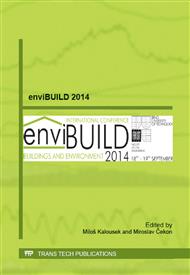p.386
p.390
p.395
p.399
p.403
p.408
p.412
p.419
p.424
Evaluation of Indoor Daylight Parameters during Long–Term Observations in the Rooms Equipped with Intensive Coloured Surfaces
Abstract:
Examination, design and control of internal light conditions belong to important actual architectural issues. In most cases the reason is increasingly growing interest in non-visual response of human on the ambient light properties. Sick Building Syndrome (SBS) is assumed to be caused by complex of inappropriate indoor environment circumstances. Unsuitable light conditions are regarded to be one of them. This paper deals with comparison of internal light parameters such as photopic illuminance level EV, Spectral Power Distribution (SPD) and definition of peak wavelength value recorded in tested office rooms, which were scaled down to models for easier handling. Models are equipped with different selected colored wallpapers and flooring materials, whereby one model remains with all surfaces in neutral colors. The outputs of measured parameters are compared with each other and also with outdoor levels of the same light properties. There is also defined filtration efficacy of blue light component assumed to be most effective for controlling of non-visual sensoring system of human body. This observation may provide more complex overview on selection of internal surfaces colors in long-term occupied spaces, taking health and wellbeing into consideration.
Info:
Periodical:
Pages:
403-407
Citation:
Online since:
October 2014
Authors:
Price:
Сopyright:
© 2014 Trans Tech Publications Ltd. All Rights Reserved
Share:
Citation:


